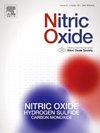内皮细胞和红细胞一氧化氮合酶在贫血期间调节心血管功能中的不同作用
IF 3.2
2区 生物学
Q2 BIOCHEMISTRY & MOLECULAR BIOLOGY
引用次数: 0
摘要
红细胞(rbc)表达功能性内皮一氧化氮合酶(eNOS),该酶独立于内皮细胞(ECs)的eNOS调节血压(BP),并在急性心肌梗死(AMI)期间提供心脏保护。RBC-和EC- eNOS在贫血中的功能作用尚不清楚。本研究评估了红细胞或ec特异性eNOS缺失对失血性贫血患者血流动力学和心功能的影响。方法和结果在EC或rbc特异性eNOS敲除(KO)小鼠及其对照中诱导贫血。红细胞- enos - ko小鼠在基线和贫血条件下均保留了体内血流介导的舒张(FMD),但与各自的对照组相比,EC-eNOS-KO小鼠的FMD受损。钢丝肌图分析显示,红细胞- enos - ko小鼠的主动脉环保留了内皮依赖性松弛(EDR),而与对照组相比,EC-eNOS-KO小鼠的EDR被消除。Miller导管血压测量显示EC-eNOS-KO小鼠在基线和贫血条件下的收缩压和舒张压升高。与对照组相比,红细胞- enos - ko小鼠的收缩压和舒张压均升高,而与各自的对照组相比,贫血红细胞- enos - ko小鼠的这些参数保持不变。超声心动图显示,在基线、贫血后3天和再灌注AMI后24小时,所有基因型的心功能都保持不变。然而,与对照组相比,贫血红细胞- enos - ko小鼠的梗死面积显着增加。结论贫血可减轻红细胞-eNOS缺失引起的血压升高,而高血压在内皮细胞eNOS缺失的情况下持续存在,这表明血管eNOS是贫血条件下血压的主要调节因子。红细胞- enos在贫血条件下限制梗死面积。本文章由计算机程序翻译,如有差异,请以英文原文为准。
Divergent roles of endothelial and red blood cell nitric oxide synthase in regulating cardiovascular function during anemia
Background
Red blood cells (RBCs) express functional endothelial nitric oxide synthase (eNOS), which regulates blood pressure (BP) independently of eNOS in endothelial cells (ECs) and provides cardioprotection during acute myocardial infarction (AMI). The functional role of RBC- and EC- eNOS in anemia remains unknown. This study evaluated the effects of RBC- or EC-specific eNOS deletion on hemodynamics and cardiac function in blood loss anemia.
Methods
and resultsAnemia was induced in EC- or RBC-specific eNOS knockout (KO) mice and their respective controls. In vivo flow-mediated dilation (FMD) was preserved in RBC-eNOS-KO mice under both baseline and anemic conditions but was impaired in EC-eNOS-KO mice compared to their respective controls. Wire myograph analysis of aortic rings showed preserved endothelium-dependent relaxation (EDR) in anemic RBC-eNOS-KO mice, while EDR was abolished in anemic EC-eNOS-KO mice relative to controls. Miller catheter BP measurements revealed elevated systolic and diastolic BP in EC-eNOS-KO mice under both baseline and anemic conditions. Both systolic and diastolic BP were increased in RBC-eNOS-KO mice compared to controls, whereas these parameters remained unchanged in anemic RBC-eNOS-KO mice compared to their respective controls. Echocardiography demonstrated preserved cardiac function across all genotypes at baseline, 3 days post-anemia, and 24 h post-reperfused AMI. However, infarct size was significantly increased in anemic RBC-eNOS-KO mice compared to controls.
Conclusions
Anemia mitigates the BP elevation caused by RBC-eNOS deletion, while hypertension persists in the absence of endothelial eNOS, highlighting vascular eNOS as the predominant regulator of BP under anemic conditions. RBC-eNOS limits infarct size under anemic conditions.
求助全文
通过发布文献求助,成功后即可免费获取论文全文。
去求助
来源期刊

Nitric oxide : biology and chemistry
生物-生化与分子生物学
CiteScore
7.50
自引率
7.70%
发文量
74
审稿时长
52 days
期刊介绍:
Nitric Oxide includes original research, methodology papers and reviews relating to nitric oxide and other gasotransmitters such as hydrogen sulfide and carbon monoxide. Special emphasis is placed on the biological chemistry, physiology, pharmacology, enzymology and pathological significance of these molecules in human health and disease. The journal also accepts manuscripts relating to plant and microbial studies involving these molecules.
 求助内容:
求助内容: 应助结果提醒方式:
应助结果提醒方式:


